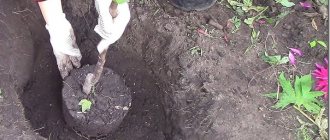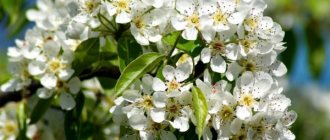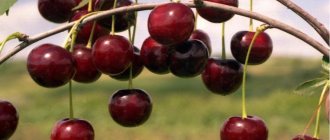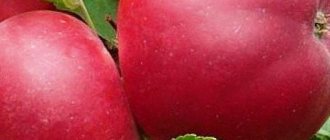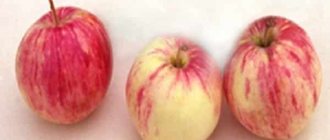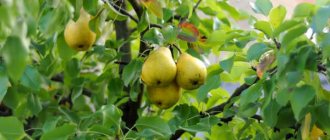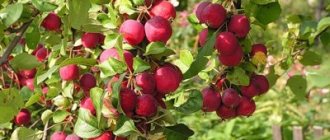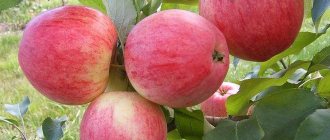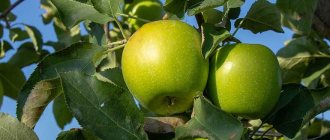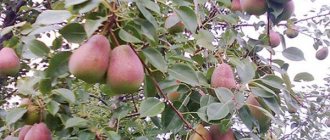Many gardeners think that the apple tree is a truly Russian fruit crop. However, for centuries, this crop has been successfully grown in other countries of the world. Thanks to the work of breeders and farmers, more and more different varieties of apple trees are appearing that meet a variety of requirements. This apple tree variety was obtained thanks to American breeders. At the moment, Red Chief is in great demand both in America and in our country. In order for such plants to produce the maximum amount of fruit, you need to know about the peculiarities of growing this variety.
Description and characteristics of the Red Chief apple tree
Red Chief is an autumn early fruiting variety. Thanks to the excellent presentation of the fruit and high yield, the variety is ideal for commercial cultivation. The fruits ripen around the end of September and reach consumer maturity in December.
Characteristics of the Red Chief variety:
- Tree. Medium height, with a compact rounded crown. This allows you to plant apple trees of a different variety nearby without fear that the trees will compete. The annual growth of the tree is 5-7 cm.
- Fruit. Relatively large. On average, the weight is 180-200 g. Individual specimens can reach 400 g. They have a conical, slightly elongated shape, with 5 tubercles at the top of the apple. The creamy flesh is quite dense and does not differ in juiciness. The main background is green-yellow, but a bright red integumentary color spreads over the entire fruit. The skin of the apple is covered with wax, which is easily visible on the surface. The taste is high, the tasting score is 4.8 out of 5 possible.
Pollinators
Despite its high productivity, Red Chief is not self-fertile. In order to maintain such a high level of productivity, our hero must have reliable pollinators. The most suitable flowering dates are Gloucester, Golden Delicious, Elstar.
A big advantage of our hero is the possibility of growing it using compacted planting technology. This is greatly facilitated by the compact crown. The most successful rootstocks for the crop are M9 and MM106. For example, on M9 rootstock, an apple tree can be grown using a trellis method, which makes it easy to care for the tree and easily harvest.
Pros and cons of the variety
Advantages:
- Sealing density. This is possible due to the compact crown and medium height of the tree. The condition is the use of medium-growing or low-growing rootstocks.
- Precociousness. Two years after planting in a permanent place, the apple tree begins to bear fruit.
- Attractiveness of fruits. Apples are beautiful and tasty - ideal for sale. The fruits contain a lot of sugar and vitamin C, and a small percentage of acids.
- The fruits are insensitive to mechanical damage and are well transported.
- Long shelf life of apples. Even without special conditions and equipment, the fruits remain marketable until February.
- Wide distribution area.
- Low maintenance requirements.
- High immunity against powdery mildew and fire blight.
Flaws:
- Insufficient frost resistance. It is necessary to insulate the tree for the winter.
- Does not tolerate drought well. It is important to moisten the soil in a timely manner.
- Low resistance to bitter spotting, glassy pulp, rot and scab.
Fruiting and productivity
Red Chief is a high-yielding variety. Fruiting is affected by:
- Age of the tree. The first harvests are limited to 30 kg per tree. With age, the tree's fertility increases - one plant can produce up to 120-150 kg of apples.
- Weather. Yields drop if there were extremely low temperatures in the winter, or if there was a hot, dry period in the summer. It even happens that after unfavorable weather, periodicity appears in fruiting.
Preparing and planting a Red Chief apple tree
Before planting seedlings, the gardener must select a suitable site and prepare a hole for planting on it. The further growth and fruiting of the tree depends on the characteristics of the site and the starting growing conditions.
Site selection and soil preparation
The development of an apple tree and its productivity largely depend on the planting location. When deciding where to plant a Red Chief seedling, take into account the following requirements for the site:
- Good lighting. In order for the fruits to acquire a bright color during the ripening period, sunlight must fall on them.
- No drafts and protection from the north wind.
- Avoiding stagnation of water - do not plant seedlings in depressions and depressions.
- The optimal soil type is loam. On sandy loam soils, the variety's frost resistance indicators decrease.
- Low groundwater level. The proximity of water provokes rotting of the roots and the seedlings may die.
Sites on slopes and hillocks are welcome. It is recommended to plant on the south side of buildings, structures, fences - they will cover the plant during return frosts.
For planting, seedlings are taken on medium- or low-growing rootstocks. Then the trees are planted according to the scheme - 4x1.5 m.
Soil preparation:
- Autumn. Closer to autumn, the soil is cleared of agricultural residues and dug up. Digging is not delayed for long - it is better to do it at the end of summer or early autumn. All weeds that emerge after digging are removed. Digging depth is the level of the fertile layer.
- Spring. In spring the soil is loosened. Thanks to loosening, the soil crust formed over the winter is destroyed, and the evaporation of moisture from the soil is also prevented.
There is an opinion that digging before planting seedlings is not necessary, but this agricultural technique has serious advantages:
- the soil accumulates moisture and nutrients;
- pest larvae move closer to the surface and freeze out in winter;
- the fertile layer is leveled over the entire surface.
Next, soil preparation is carried out taking into account its type:
- Clayey. The soil is dug up half a meter. Its composition is improved with humus, sawdust, river sand, rotted manure, peat or compost, and lime. Then mineral fertilizers are applied - complex (100-150 g) or superphosphate (70 g), as well as potassium fertilizers (50 g).
- Sandy. A year before planting seedlings, the soil is dug up - no more than half a meter. Clay, compost, manure, peat, humus, lime, potassium and superphosphate are added.
If you have to plant a whole garden, then the soil is sown with green manure. When the grass grows, it is mowed and left to lie until dug up.
Deadlines and requirements
Seedlings can be planted in spring and autumn. It is recommended to do this:
- in the end of April;
- in mid-September or early October.
When choosing autumn for planting seedlings, it is necessary to take into account the risks associated with frost. Trees are planted so that there is at least a month between the day of planting and probable frosts. This time is necessary for high-quality rooting of seedlings.
When choosing a planting time, the specific climatic features of the region are also taken into account. For example, in the Moscow region, spring planting is preferable.
Step-by-step planting recommendations
The procedure for planting seedlings:
- Planting pattern – 4x1.5 m.
- The depth of the pit is 60 cm, width is 70 cm.
- Drainage - dry branches - is placed at the bottom of the hole. Peat and humus are poured on top.
- After sprinkling organic fertilizer with soil, place the seedling on a mound, straightening the roots. Fill the hole with soil and water the seedling with two buckets of water.
Rules for planting seedlings
In order for the varietal “Snow White Apple Tree” seedlings to take root well on the site, and in the future to develop and bear fruit well, you must first take into account several important planting rules:
- the place should be without significant groundwater; from their abundant rising and prolonged presence in the soil, the root system of the trees will quickly begin to die. To identify unfavorable places in advance, you should pay attention to the following sign: dry top at the root of the seedling;
- the site for planting must be chosen open and with good sunlight;
- on the north side, plantings should be protected from strong, cold winds;
- the soil should be chosen loamy, since on sandy soils the winter hardiness of this species will be significantly reduced;
- It is advisable to place plantings on the south side of buildings, this will provide the plants with additional shelter during return frosts;
- the selected plants should be planted only on low-growing or medium-growing rootstocks. The planting pattern, in this case, should look like this: 4x1.5 m;
- the best pollinators for this species are the following varieties: “Golden Delicious”, “Gloucester” and “Elstar”.
Tree care
Caring for the Red Chief variety includes the entire set of standard agrotechnical measures. The yield depends on the correctness and timeliness of performing the procedures described below.
Watering and mulching
Throughout the spring-summer season, apple trees must receive the required amount of moisture. Watering is done as needed - the soil should not dry out, but the water in it should not stagnate, moderate moisture is necessary.
After watering, the soil must be loosened - around the trunk and over the entire area covered by the crown. During loosening, weeds are removed - they absorb nutrients destined for the tree. In addition, loosening ensures air circulation in the soil.
The soil is a tree trunk circle, mulched in the fall. This event prevents the roots from freezing in winter. Materials that improve the structure of the soil, nourish it, and protect it from erosion, leaching, freezing and drying out are used as mulch.
When choosing mulch, take into account the ability of the material to pass air into the soil and release harmful compounds from it. For Red Chief mulch, it is best to use humus, but the following will also work:
- sawdust;
- mown grass;
- fallen leaves;
- hay;
- organic compost.
Fertilizer
Fertilizers applied during planting last a long time for the seedling. Further feeding proceeds according to a simple scheme:
- In the summer, in the first year of planting, nitrogen fertilizers are applied.
- In the year of the first fruiting, potassium-phosphorus fertilizers are applied.
- During the first flowering it is necessary to add superphosphate or urea.
When the tree begins to bear fruit, it is fed 4 times per season - with mineral fertilizers and urea.
All fertilizing is applied to the tree trunk circle. Fruiting apple trees are fed 3-4 times a year:
- At the end of April, urea (500-600 g) is added or humus is scattered around the tree (6 buckets).
- During flowering, the tree is fed a second time. In hot weather, fertilizers are applied in liquid form. Superphosphate (1 kg), potassium sulfate (800 g), slurry (10 l) and liquid bird droppings (5 l) are dissolved in 200 l of water. Instead of manure and droppings, you can add urea (500 g). One tree – 40-50 liters of solution. Before fertilizing, the tree is watered, then fertilizer is applied and watered again.
Fertilizer application rates taking into account the age of the fruit tree
| Year of planting | Diameter of the trunk circle, m | Organic fertilizers, kg | Nitrogen, g | Phosphorus, g | Potassium, g |
| 2 | 2 | 6 | 10 | 10 | 15 |
| 3-4 | 2,5 | 10 | 20 | 20 | 30 |
| 5-6 | 3 | 15 | 30 | 30 | 45 |
| 7-8 | 3,5 | 20 | 60 | 40 | 60 |
| 9-10 | 4 | 25 | 75 | 50 | 75 |
| 11-12 | 5 | 40 | 120 | 80 | 150 |
Spraying and pest control
The Red Chief variety suffers most from:
- Scabs. This is a fungal disease that affects literally all parts of the tree, including the fruits. The disease can completely destroy the crop. To combat scab, fungicides are used - Skor, Horus, Raek, Bordeaux mixture. Treatments with horsetail infusion and dry mustard solution are also useful.
- Spotting. Another fungal disease that affects apple leaves. For prevention, the tree is sprayed with Bordeaux mixture or copper oxychloride. A folk remedy is an infusion of ash and garlic.
- Apple codling moth. The larvae of this pest eat the pulp of the fruit, taking a good part of the harvest. For control, a complex of agrotechnical measures and spraying with insecticides are used.
For preventive purposes it is recommended:
- remove plant debris in a timely manner;
- dig up the soil in the fall;
- thin out the crown, ensuring normal air circulation;
- plant apple trees at higher elevations.
Spraying order:
- First treatment - before the buds open, the trees are sprayed with insecticides.
- After flowering , repeat spraying with insecticidal preparations. If you are late, most of the fruits will be affected by the codling moth.
- The last treatment is during fruit filling, but no later than a month before harvesting.
It is strictly forbidden to spray trees during flowering - this will kill pollinating insects and destroy many ovaries.
Basic care measures
To obtain a good and stable harvest, it is not enough to follow the rules of agricultural technology when planting a seedling. It is necessary to pay attention to tree care.
Watering frequency
The apple tree is not a moisture-loving crop and will not need to be watered often. 4 irrigations per fruiting season are sufficient:
- The first watering is carried out during the period of swelling of the buds.
- The second is with the onset of flowering.
- The third time the soil is moistened during the formation of ovaries.
- The last time was before the onset of frost in October.
It is not recommended to water plants with cold water. This increases the risk of fungal diseases.
In the first half of summer, nitrogen is added to the soil. Nitrogen-containing compounds include ammonium nitrate, urea or ammonium sulfate. Organic fertilizers are also added to the soil.
During the fruiting period, the soil is fed with superphosphate and potassium fertilizers.
Loosening the soil
The soil is loosened to a depth of 15 cm before each watering.
Crown formation
The tree is formed 2-3 years after planting the seedling. In the spring, young shoots are cut down, some of the branches are cut off, leaving 3-4 skeletal ones. In autumn, dry branches are removed.
Treatment with prophylactic agents
In spring, the apple tree is sprayed with Bordeaux mixture or other copper-containing preparations. If necessary, spraying is repeated during the flowering period.
Preparing the tree for winter
Before the onset of cold weather, the soil around the trunk is mulched. Also, to prevent rodents from gnawing on the bark, it is smeared with lime or the trunk is tied with spruce branches.
Trimming
Scheme for pruning apple trees:
- The first pruning is carried out immediately after planting the seedling - its central conductor is cut by 15 cm, leaving no more than five buds.
- In the second year, they begin to form the crown - pruning is carried out so that the branches are not opposite each other.
- In the future, sanitary pruning is performed - freeing the tree, as necessary, from diseased, damaged and weakened branches.
After each pruning, the sections are treated with garden varnish to prevent infection.
How to plant an apple tree
The productivity of the apple tree depends on the correct planting.
Preparatory activities
Before planting, dig a hole 2 weeks before planting and mix the top layer of soil with manure, mineral fertilizers and ash. Then they fill the bottom of the hole with it. Immediately before planting, the root system of the apple tree is dipped into a liquid clay solution.
Selecting a location
The apple tree prefers to grow in open sunny areas, on light and fertile soils.
Disembarkation dates
In spring, seedlings are planted after the threat of frost has passed. This is approximately the end of April - May. In autumn, planting is done in October, before the onset of cold weather.
Planting scheme and technology
The distance between other trees should not be less than 3 m. To plant a seedling, dig a hole 1 m deep and 70-80 cm wide.
Reproduction
The Red Chief variety is sold by nurseries that sell fruit tree seedlings. Amateur gardeners, if desired, can grow a Red Chief apple tree on their own.
Three methods of reproduction are practiced:
- cuttings;
- layering;
- vaccination.
A tree propagated by any of these methods retains its original varietal characteristics. And if grafting is a rather difficult method of propagation for beginners, then anyone can grow a tree from layering and cuttings.
We recommend reading an article that will tell you about spring grafting of an apple tree.
Reproduction by layering:
- An annual tree is planted, making a large slope towards the ground.
- Young shoots are dug in in the spring.
- Shoots formed from buds are hilled and watered.
- In autumn, rooted shoots are insulated.
- When the next spring comes, the shoots are cut off from the mother plant with pruning shears and planted in a place prepared for planting a new tree.
Propagation by cuttings is even simpler - the branch is broken and fixed. Then they cut it and immerse it in water with activated carbon for three weeks to take root. The finished planting material is planted in a greenhouse.
Growing in regions
In outskirts of Moscow
For better development of the Red Chief apple tree in the Moscow region, you need to plant it correctly.
The seedlings are planted in this region in early spring . Autumn plantings are undesirable. If the tree is purchased in the fall, it is buried in a hole and left in this position until spring planting.
To prevent water from stagnating in the root system of the tree, I make drainage from stones in the hole before planting. Then a small amount of black soil is added, the seedling is installed and covered with soil.
To avoid frosting of a tree in this region, it must be insulated in the autumn.
It is also worth paying attention to rodents. In the fight against them , various baits are installed that will distract pests from the seedling.
In Ukraine
In order for the Red Chief apple tree to produce a consistently high yield without periodicity in fruiting on the territory of Ukraine, it is necessary to properly care for the plant:
- This region generally has low groundwater levels. To avoid rotting of the tree's root system in rainy weather, it is worth regularly loosening the soil near the tree trunk;
- Spring and autumn whitewashing of the trunk with lime will help avoid burns to the trunk from the ultraviolet rays of the sun;
- Basic fertilizers, such as potassium, phosphorus and manure, are applied immediately before planting the seedling.
Growing in Ukraine requires proper care.
Important! Concentrated fertilizers are undesirable, as they cause burns to the root system of the tree.
In the middle zone
If you take into account several nuances, the Red Chief apple tree can grow well and bear fruit in central Russia.
If the seedling is planted on clay soils, you need to add compost, sand, humus and organic fertilizers to the planting hole.
To avoid the development of various diseases it is necessary to keep the garden clean by weeding and removing fallen leaves.
Timely fertilizing with nitrogen and mineral fertilizers will contribute to better yields and annual fruiting.
Preparing for winter
Preparing the apple tree for winter is preceded by sanitary pruning and cleaning under the tree. Leaves are removed from the tree trunk circle and the soil is dug up. Preparations for wintering begin no earlier than the average daily temperature reaches 10 °C.
Procedure for preparing for wintering:
- whitewashing the lower branches and base of the apple tree trunk (read more about whitewashing an apple tree here);
- mulching with humus;
- protection from rodents and frost.
How to protect a seedling from freezing:
- a support or frame is built around the trunk;
- throw burlap over the seedling and tie it tightly with twine - carefully so as not to damage the trunk;
- As soon as snow falls, it is thrown on top of the seedling, covered with burlap.
To insulate seedlings, you cannot use non-woven material that does not allow air to pass through.
In adult apple trees, the root system is insulated - spruce branches are thrown into the tree trunk circle, which will protect the roots of the tree from freezing. Spruce branches can also be used to insulate the trunk. The spruce branches can be secured with ropes.
To protect against rodents, different techniques are used - protective and repellent. The latter includes, for example, hanging black polyethylene or bright cardboard on branches. You can buy special repellers.
The following materials will help protect the tree immediately from frost and rodents:
- burlap - for tying;
- metal mesh - for making a fence.
It is recommended to place the poison in the holes of mice and rats - these pests should be gotten rid of in a radical way.
History [edit | edit code]
Red Delicious originated in 1880 in Madison County, Iowa. It was first described as "a round, reddened yellow fruit, unsurpassedly sweet" [4]. Stark Nurseries held a competition in 1892 to find a variety to replace the Ben Davis apple. The winner was a red and yellow striped apple sent by Jesse Hiatt, a Peru, Iowa farmer who named it Hawkeye. Stark Nurseries
bought the rights from Hyatt, renamed the variety "Stark Delicious" and began distributing it. Another apple tree, later named "Golden Delicious", was also sold to Stark Nurseries after it was purchased from a farmer in Clay County, West Virginia, [6] in 1914; "Delicious" was replaced by "Red Delicious" and became a retronym [4].
Reviews of the Red Chief variety
In their reviews, amateur gardeners, as well as ordinary consumers, left many words of praise. Particularly noted are such qualities as resistance to powdery mildew and the ability to grow in different regions of the country. The quality of the fruits is especially noted - consumers are attracted by their taste and rare beauty.
★★★★★
Gennady R., Novosibirsk. Red Chief is undoubtedly the best variety in my garden.
These apple trees do not require much care, and the harvest is excellent. There are no problems with their implementation - I personally have not seen more beautiful apples. I am going to increase plantings in order to continue to make a profit from my garden. ★★★★★
Valentina L., Krasnodar region. Even one middle-aged Red Chief tree that grows in our dacha gives a lot of positive emotions to the whole family.
We eat apples all winter – they store very well. This is my favorite variety, so I decided to propagate it by layering, although the area is small, I can find a place for 2-3 apple trees. ★★★★★
Max BC
This is how to protect a tree for the winter, the variety itself can withstand -25.
Hide
Add your review
The Red Chief variety is deservedly popular among gardeners. The only obstacle to its advancement into the regions is the harsh climate. The disadvantages of the variety are overshadowed by the obvious advantages of this variety, proven over the years - it is unpretentious, productive, large-fruited, and its apples have a truly fabulous appearance.
0
0
Copy link
Description of the variety
Photo:
To understand why the Red Chief apple tree variety is so popular, and to decide whether it is worth growing it on your property, just read the detailed description and reviews.
Trees
Red Chief apple trees are low-growing - only up to 5-7 meters. The uniform growth of skeletal branches forms an oval or round-pyramidal compact crown.
A large number of fruit rings are formed on slightly curved or straight shoots. The branches themselves have a red-brown tint and are heavily pubescent. The leaves are small, oblong.
Important! Due to these characteristics, seedlings can be placed in dense rows on the site.
Fruit
The fruits of Red Chief apple trees are large in size - the average weight ranges from 200 to 400 g. They look very beautiful, have a rich red color, and are slightly covered with a waxy translucent coating. The shape is round, slightly elongated, with 5 characteristic hill-like protrusions.
The pulp is juicy, aromatic, light cream color, high density. The taste of apples is very sweet and on a tasting scale is rated at 4.8 points, which in principle is the maximum indicator.
Important! The chemical composition of the fruits of Red Chief apple trees includes a large amount of sugars, a small part of acids, and a high content of vitamin C and P-active substances, for which they are valuable from the consumer’s point of view.
Fruiting
Red Chief apple trees are a fast-growing variety. The first harvest can be obtained already 2-3 years after planting. The harvest volumes are greatly influenced by the weather conditions of the growing region and compliance with agricultural practices.
Important! During periods of severe drought in summer or frost in winter, there may be a decline in productivity. Under the same conditions, it is extremely rare, but periodicity of fruiting may still occur.
Pollination
For high productivity of these fruit trees, it is necessary to ensure that suitable pollinating varieties are planted nearby.
The best for the Red Chief species are:
- Gloucester;
- El Star;
- Golden Delicious.
Important! Under favorable conditions, apple trees bloom in early to mid-May.
Ripening time
Red Chief is a winter variety whose fruits ripen at the end of September - beginning of October. The harvest is often harvested throughout the month until frost.
Productivity
In the first couple of years, the volumes are unlikely to exceed 30 kg per tree, but as they grow older, fruiting in a volume of 120-150 kilograms or more per tree is quite possible.
Important! The transportability of Red Chief fruits is very good. There is also a long period of storage of the crop - if all conditions are met indoors, then the fruits remain suitable for consumption and undamaged until March-April.
Collection and storage:
- When harvesting, it is important to immediately sort the fruits, removing all damaged and crushed fruits.
- It is better to pick apples in dry weather.
- When storing, select suitable containers - wooden containers are perfect. Additionally, you can wrap each apple in paper or sprinkle wood chips between the rows.
- The room should be darkened, with a temperature of about 5-7 C.
Suitable region and climate
Winter hardiness is quite high, but this variety is still recommended for planting in the southern and central regions with a temperate climate.
When growing in northern regions with constant spring frosts and thaws, as well as very low temperatures in winter, freezing may occur. High-quality autumn preparation of trees - pruning, creating shelter - will help prevent this.
